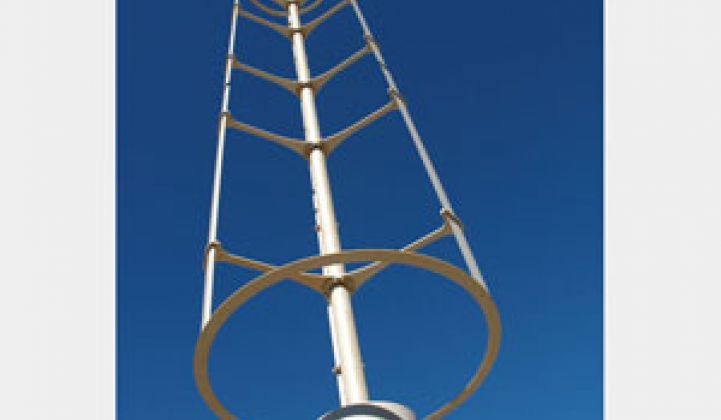[Editor’s note: This story is part of a six-article series about small wind. Click here, here, here, here and here to read the rest.]
Fans might think of the Western comedy musical "Paint Your Wagon" as one of Clint Eastwood’s least Clintwoodian films, as the film that turned Lee Marvin’s voice into a hit in Europe or the film that inspired the Simpsons’ "All Singing, All Dancing" episode.
But it’s a lesser-known fact that one of its songs, "They Call the Wind Mariah" -- an ode to a wind strong enough to blow the stars around and set the clouds a-flyin’ -- also is the melodic inspiration behind the naming of a small-wind-power developer called Mariah Power.
Founded in 2005, the Reno, Nev.-based startup has been trying to harness air currents and turn them into energy for residential and commercial markets.
The company has caught the eyes of investors and government alike. The company this month said it had closed $500,000 in funding on the way to raising a round of up to $10 million (see Mariah Power Gets a Gust of Financing).
In March, the company was selected to demonstrate its turbine on the National Mall next to the U.S. Capitol in Washington. The demonstration will be part of the "One Planet -- Ours! Sustainability for the 22nd Century" exhibit starting in May at the U.S. Botanical Garden.
And later this month, the company expects to deliver its turbine, the Windspire, to its first customer.
Unlike larger traditional wind turbines that generate electricity with propellers similar to those on airplanes, Mariah Power uses a 30-foot-tall spire that has a 2-foot radius.
CEO Mike Hess claims Mariah’s design can cut costs to 12.4 cents per kilowatt-hour over the 20-year life of the Windspire, compared with 22.6 cents per kilowatt-hour for propeller systems and 36 cents for solar-power systems. The cost-cutting improvements include mechanical advancements, including an energy-efficient, low-cost generator, as well as a motorless design and a molded plastic inverter, he said.
The company’s wind turbine also comes loaded with "electronic braking" software to keep the turbine from spinning faster than 500 revolutions per minute, the maximum power-generation point, he said.
Keeping turbines from spinning out of control is important, as illustrated by this popular YouTube video of a (non-Mariah) wind turbine exploding after its braking mechanism failed during a storm.
Its spire shape is mainly aesthetic, not an efficiency booster -- "to be able to do all that and look good too is awesome," Hess said.
Mariah Power estimates its turbine will produce about 1,800 kilowatt-hours per year in 11 mph average winds -- about a third of the electricity used by an average U.S. single-family home.
The Windspire will cost $3,995, with installation adding an additional $1,000.
Without government incentives, most customers will see a return on their investment, in the form of lower electricity bills, in about 10 years -- about half the expected life of the turbine, Hess said.
But part of the problem with small wind is that it’s still small.
According to the latest stats from the American Wind Energy Association, only 6,800 small-wind turbines, defined as less than 100 kilowatts each, were sold in the Unites States in 2006. That translates into $56 million in sales, or about 17.5 megawatts of installed capacity in the country.
Although the trade group said small wind has experienced annual growth ranging from 14 to 25 percent since 1985, the sector is only a whisper of a breeze compared to the strong gale of growth in large wind.
The total U.S. wind energy industry installed 5.24 gigawatts worth of turbines last year, according to the American Wind Energy Association, making small wind about 0.3 percent of total installations.
So why hasn’t small wind been able to stir a bigger storm?
There has been a bevy of challenges, including high costs, restrictive zoning and permitting rules, a lack of federal incentives and concerns about visual obstructions.
Also, customers can’t just put small turbines anywhere. For example, Mariah Power recommends their turbine for residential customers who have at least half an acre of land. Unlike with solar power, most homeowners can’t stick a wind turbine of Mariah Power’s size on their roof. Most roofs can’t handle the weight, for one thing.
"It’s just a fact of physics," said Peter Edwards, a partner for venture firm Altira Group. "These devices have weight, fully loaded, in the hundreds of pounds."
Mariah isn’t targeting the rooftop market, but competitors such as Aerotecture and Marquiss Wind Power are designing rooftop turbines.
Edwards believes that small wind has an investment-worthy future. His venture firm has invested in small-wind developer Southwest Windpower, which Edwards claims has overcome key obstacles, including costs, to make small wind more attractive.
Aside from Southwest, Mariah faces competitors such as Quiet Revolution, Magenn Power, Bergey Windpower, McKenzieBay, Selsam Superturbine, Windside and Renewable Devices, among others.
The whole industry has a long way to go to establish a market, but if Mariah can cut costs as expected and turn its demonstrations into attention from landowners with extra space, it could attract a market in windy places.



